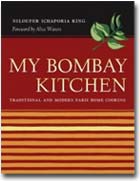Books |
My Bombay Kitchen: Traditional and Modern Parsi Home Cooking
Niloufer Ichaporia King
By
Published: Jan 01, 2007
Category:
Food and Wine
Alice Waters calls Niloufer Ichaporia King “one of the great cooks I know.” It makes Waters crazy that King has steadfastly refused to open a restaurant. But it delights Waters that, on the Parsi New Year, King consents to cook a feast worthy of her mother’s Bombay kitchen at her legendary restaurant.
I’ve never been to that dinner. Nor have I ever enjoyed an Indian meal that King might claim as her own. I’m the standard American who claims to love Indian food — I look over the menu and wonder one thing: how hot to order the curry. Oh, and maybe whether to get the king-size beer if I’ve thrown sanity to the winds and ordered a vindaloo.
But smart friends have said “My Bombay Kitchen” is the cookbook event of the year.
And Alice Waters — she created Chez Panisse and almost singlehandedly launched the good food movement — certainly knows her way around an entree.
And as even a skim of her book indicates, Niloufer Ichaporia King doesn’t cook the mundane fare I’m used to.
One reason fits all: Niloufer Ichaporia King’s people are not quite “Indian”.
The Parsis were Persians who migrated to southern India from Persia. They had a highly evolved culture, heavily shaped by the teachings of Zoroaster, a prophet who lived in the seventh century before Christ. King calls Zoroastrianism “a religion of conduct rather than piety,” for it holds that all people — that includes both sexes — are equal, that we are stewards of the earth, and that life is “an ongoing struggle between light and dark forces within each human being.”
Because Bombay is a port city and a commercial hub, its tastes were sophisticated when King was growing up there. So was its food — as King writes, Bombay had “a real magpie cuisine” that drew upon the old ways and, at the same time, featured local modifications of the food of other traditions.
King learned about food from her mother and the family cook, then went off to boarding school, where food was “a constant preoccupation” and luxury was “a can of baked beans after lights out.” Though she moved to America, she had a keen memory of her childhood meals and the joys of “a diet not constrained by religion.” With the help of her mother’s recipes — and her mother — she began to use her training as an anthropologist to chronicle Parsi cooking.
Most of her recipes will be of interest primarily to hard-core foodies. Are you likely to make your own Indian breads? Have a hankering to whip up some brain cutlets? Can your butcher get kid for you? And how about banana leaves to wrap fish filets?
So what’s left to the amateur chef — or, more urgently, the home cook who’d like a modest expansion of his/her repertoire?
Just enough recipes to justify the purchase — and whet the palate for the more adventurous recipes.
Sio I’m starting with Parsi crudités, a selection of off-the-beaten track vegetables (jicama) and fruits (green mango crescents), accompanied by bowls of salt and cayenne pepper and lime wedges. Then it’s on to carrot and coriander soup, served hold or cold. Lamb shanks spiced with a ginger-garlic paste, cumin seeds and red chiles. Irish stew (yes, Irish stew). Cashew cream chicken, with its “thick, creamy” gravy. Caramelized fried rice. And a cauliflower custard.
Which recipe will most tempt you? I vote for the custard. It took me just minutes to prepare. It was, like so many great dishes, even better the second day. And, I can happily report, it was at once as familiar as quiche and exotic as…well, Bombay.
Wobbly Cauliflower Custard
Serves 4 to 6
1 small cauliflower (about one pound)
4 large eggs
3 cups warm milk
1 cup (or more) grated Cheddar, Monterey Jack, Parmesan or Fontina cheese
chopped fresh green or red chiles (optional)
salt to taste
Heat the oven to 350 degrees. Lightly butter a 1-to-2 quart baking pan.
Boil the cauliflower (whole or cut in half) in lightly salted water until tender. Break it into small florets, chop the stem into small bits, salt lightly. Crowd the cauliflower into the baking pan.
Beat the eggs lightly with the warm milk. Add about three-quarters of a cup of the grated cheese and, if using, the chiles to taste. Pour over the cauliflower, which should be covered but not drowned. Strew the rest of the grated cheese over the top.
Put the baking dish in a larger pan containing enough warm water to come 2 inches up the side. Bake about 30 minutes. The custard should be very wobbly, and the top should be set and golden but not at all brown.
Remove the pan from the oven and let it stand at room temperature for 5 to 10 minutes before serving.
To buy “My Bombay Kitchen” from Amazon.com, click here.


